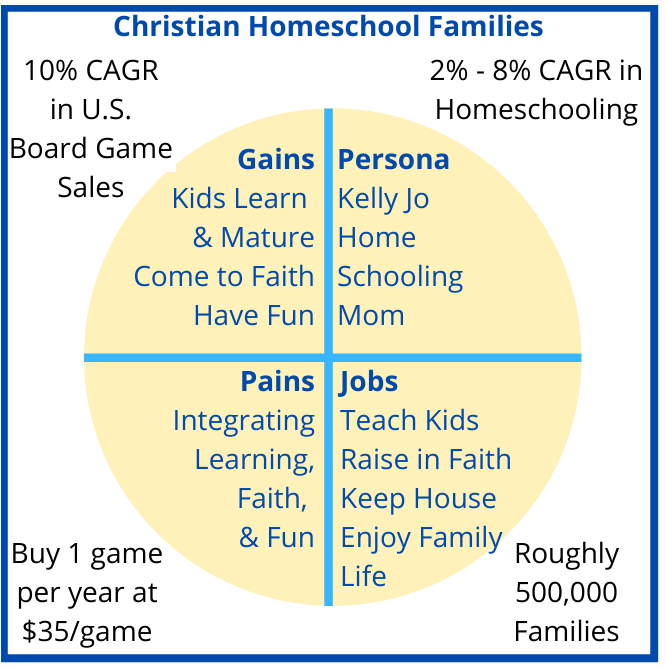One of the most important early decisions that a startup can make is who they are setting out to serve. A startup generally is built upon a key hypothesis that someone needs something (and that the solution the startup has in mind will meet that need). Clearly identifying that “someone” sets the stage for testing that hypothesis and (if the hypothesis is right) eventually being very focused in marketing to the right audience.
In the last article on SDG Games, we identified the problem that the business was setting out to solve as: “When most Christians read the Bible, they don’t know much about the geography being discussed, and so they lose valuable context in the stories that God has provided ‘for teaching, for reproof, for correction, and for instruction in righteousness’ (2 Timothy 3:16).”
So, as we set out to identify the target market for SDG Games, we can start with a fairly broad definition of “Bible-reading Christians.” Even if we narrow that down slightly to those in the United States, we are still dealing with a very broad market. According to the Pew Research Center’s Religious Landscape Study about 71% of Americans identify as Christian, and 45% of those read their bible at least once a week, so the Bible-reading Christian market would be nearly a third of the U.S. population.
In one sense, that’s good. That means that there is a very large potential market for SDG Games. But in another sense, that’s not good. There’s no way we can develop a deep understanding of the needs of a market this broad and diverse. As a startup, we need to focus on meeting the specific needs of a specific group of potential customers. If we can delight them, they can become advocates and evangelists for the broader market.
Given the nature of the first game that we are developing, we think it will appeal best to families playing games. So, the first step in segmenting the market would be to focus on those Christians who regularly read the Bible and who are parents. According to the Pew report, 30% of adult Christians are parents, and a slightly higher percent of parents regularly read scripture daily than non-parents, so a conservative estimate is that Bible-reading Christian parents make up an estimated 9% of the adult population — or about 22 million people. According to Pew, 58% of Christian adults are married (52%) or living together (6%), so doing simple math, 22 million parents translates to about 16 million households. That’s still a pretty big and diverse population!
Going one step deeper, since a key focus for SDG Games is that our games be educational, perhaps our initial target market should be Christian Homeschooling Families. There’s an estimated 4.0–5.0 million homeschooled children in the United States. Based on household size data from the National Center for Education Statistics, I estimate that there are an average of 2.27 homeschooled children per homeschooling family, so that means there are around 2 million homeschooling families in the U.S. These families homeschool for a variety of reasons and there’s is significant demographic diversity, but homeschooling has been particularly popular among conservative Christian families. I would guess 10% — 50% of all homeschooling families are Christian, so somewhere in the range of 200,000 to 1 million households. That’s a big enough market to go after, but a focused enough market to deeply understand and target.
Identifying the target market (Christian homeschooling families) is good, but to deeply understand the needs of this market, we need to take our thinking down to the level of the individual decision maker and how she will value what we have to offer. Marketers often use the concept of a persona to achieve this. They give the persona a personal name, describe her occupation, her family status, her demographics, and then a variety of factors on what, where, and how she buys the things she buys.
So here’s a hypothetical persona for our target customer:

Age: 35
Occupation: Homeschooling Mom/Homemaker
Family: Married with 2 Kids: Zach age 12 and Erin age 9
Websites/Magazines: Facebook, SimpleHomeschool.net, The Old Schoolhouse
Where Shop: Amazon, ChristianBook.com, Sonlight.com
As part of deeply understanding this hypothetical customer, we need to create a profile of how products like ours might fit into her life and work. The approach that I like to use is borrowed from Value Proposition Design, a book by Alex Osterwalder and his team at Strategyzer. It can best be understood as asking Kelly Jo three questions and imagining her answers: What jobs are you trying to do? What do you hope to gain by doing those jobs? What are the obstacles, risks, and bad outcomes that make it painful to accomplish those jobs and achieve those gains?
I imagine Kelly Jo describing her jobs as teaching her kids the content and skills they need to be successful in life, raising her kids in the faith, keeping the house running smoothly, and enjoying life together.
In the near term, the gains she hopes to get out of these jobs include the satisfaction of seeing her kids learn and mature (and learning alongside them), the joy of seeing them come to faith in Christ, and having fun doing it all. In the longer term, she has hopeful expectation of seeing her kids be successful in their families, careers, and faithful walk with Christ.
However, the pains encountered along the way include the challenges in integrating those activities and goals (e.g. teaching important content/skills without compromising Biblical truth, keeping on academic schedule in a way that is enjoyable for all, getting everything done in the home and classroom). Sometimes Christian-specific resources fall short on the quality or fun aspects. Sometimes academic resources contradict Biblical teaching. It’s hard to make school fun. And the laundry and dishes sometimes pile up while we complete a big school project.
We can’t hope to introduce products that will deliver all those gains or eliminate all those pains, but understanding them all helps us as we develop our games to keep Kelly Jo’s overall needs in perspective.
Based on those hypotheses, we can represent all of this with a customer profile:

Of course, all of these are hypotheses which will be tested. More about that in my next article in this series.

